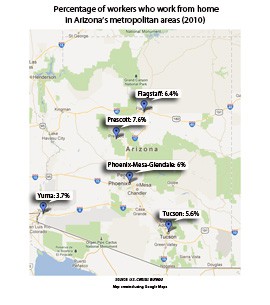Cronkite News has moved to a new home at cronkitenews.azpbs.org. Use this site to search archives from 2011 to May 2015. You can search the new site for current stories.
Prescott area among top in nation for percentage of at-home workers
WASHINGTON - Angie Garrotto never liked punching a clock, so for more than eight years now she has run her cleaning service, Completely Clean, out of her home in Prescott.
It’s Yavapai County business owners like Garrotto who helped push the Prescott metro area to the seventh-highest in the nation for the percentage of people who worked out of their homes in 2010, at 7.6 percent.
“I don’t find it surprising at all,” Garrotto said of the prevalence of Prescott at-home workers. “A lot of the businesses we clean are home-based businesses. I’m not sure what they all do, but I see a lot of them.”
The Census Bureau said at-home working arrangements, which include telecommuters and home-based businesses, have increased steadily since 1997, reaching 4.3 percent of the U.S. workforce in 2010.
That trend was mirrored in Arizona, where every metro area saw its percentage of at-home workers increase between 2005 and 2010.
The Phoenix and Tucson areas had the state’s greatest increases, adding 33,000 and 7,100 at-home workers respectively. Prescott’s rate rose slightly, from 7.2 percent to 7.6 percent, even though the actual number of at-home workers fell along with the size of the area’s workforce over the period.
Prescott-area officials attribute their relatively high at-home work numbers to the lack of ready jobs in the area, the entrepreneurial spirit of residents and the low startup and overhead costs of a home business.
The statistic does not surprise Rick Marcum, director of the Yavapai College Small Business Development Center.
“We have always had a lot of home-run businesses, so maybe that stat has been there for a long time,” Marcum said. “We get a lot of entrepreneurs and start-up activity here.”
Another factor that could be driving Prescott residents to start businesses is the unemployment rate in the area: The U.S. Bureau of Labor Statistics put Prescott’s jobless rate at 9.3 percent in August.
“A lot of people come here and there are no jobs,” Marcum said. “So the entrepreneurial jobs start.”
While some cities try to attract successful companies with hopes that jobs will follow, Marcum said many in Prescott just create their own. His center acts as a training resource for people looking to do so.
One of those people was Kim Welsh, who turned to Yavapai College for help when she started In Recovery Magazine, which she publishes out of her home just north of Prescott.
Welsh had overcome her own addiction to alcohol and drugs, and was working as a behavioral health technician in a residential treatment program to help others overcome addiction, when she decided to start the magazine.
“I had a really good full-time job,” Welsh said. “It wasn’t a matter of looking for or not having enough income.”
But as she saw little potential for job growth, she dropped down to part-time and dedicated herself to running her magazine.
“I wanted something that I was going to be passionate about and help more people than the 30 or so that come in (to the clinic) each month,” Welsh said. “I wanted to do something nationwide and something that was going to take me into retirement.”
Since starting the magazine in February with no business experience, Welsh has received training from the college’s Small Business Development Center and its senior business adviser, Fred Kennedy.
“Fred has been a lifesaver,” Welsh said. “I knew absolutely nothing about business. Without him I wouldn’t have known to incorporate my business. When it comes time to do taxes, I will be able to do everything on the up-and-up.”
Besides legal and financial guidance, Marcum said his staff helps home-business owners develop business and marketing plans, create a professional workspace at home and stay informed on licensing and zoning issues.
“We had a client a while back that wanted to do a childcare business out of their home,” Marcum said. “That requires a license and inspections.”
Marcum’s center offers a 12-course entrepreneurship program for small business owners of all kinds, home-based or not.
“Our main goal is to shore up gaps in their knowledge so they can run their business,” he said.
For Garrotto – who ran a home daycare center before starting her cleaning company – the benefits of being her own boss include flexible hours that let her provide for and spend more time with her two teenage kids.
But there are negatives, too, that come with having to operate the whole business on her own.
“The only con would be being self-employed and dealing with the stress,” Garrotto said.
She has made workplace concessions to her home business, adding an office from which she runs the company. The office has a separate entrance, which lets her divide work and home life and “feels more professional” to her five employees when they come to the office.
“My life has moved in the direction of accommodating my business more,” Garrotto said.
But she doesn’t ever see a time when she will give up the at-home work.
“The house I’m in is perfect,” she said.







